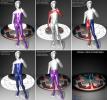Spinal Cord Syndrome, Epidural Spinal Cord Compression, Acute Spinal Cord Compression, Spinal Cord Compression, Partial Cord Syndrome, Quadriplegia, Paraplegia
- See Also
- Definitions
- Paraplegia
- Complete paralysis of the lower part of the body including the legs
- Level of thoracolumbar spine lesion determines deficits
- Quadriplegia
- Paralysis of all four limbs and trunk
- Level of Cervical Spine lesion determines deficits
- Symptoms
- Acute neck or back pain
- Extremity weakness or paralysis
- Sensory deficits with broader distribution than individual Dermatomes
- Changes in bowel or Bladder function (e.g. acute urinary or stool retention or Incontinence)
- Spinal mass (e.g. Epidural Neoplasm) may result in pain worse when lying down (supine, recumbent)
- History
- Acute Spinal Trauma
- Cervical Spine Injury is most common level of cord injury
-
Epidural Neoplasm
- Thoracic Spine involvement is more common
- Review malignancy risk factors
-
Epidural Abscess Risks
- Thoracic Spine involvement is more common
- Fever
- Immunosuppression
- Intravenous Drug Abuse
-
Spinal Epidural Hematoma Risks
- Anticoagulation
- Spinal Procedures (e.g. Spine Surgery)
- Exam
- See Trauma Exam
- See Neurologic Exam
- Back exam
- Post-void Bladder scan or POCUS for Residual Volume
- Rectal Exam for tone
- Exam
- Distinguishing Upper from Lower Motor Neuron Injury
-
Upper Motor Neuron Lesion (lesion proximal to the spinal cord anterior horn cells)
- Hyperreflexia
- Clonus
- Motor Spasticity
- Increased Muscle tone
- Babinski Sign positive
- Muscles without atrophy (normal Muscle mass)
-
Lower Motor Neuron Lesion (lesion distal to the spinal cord anterior horn cells)
- Motor Weakness to Flaccid Paralysis
- Muscle Atrophy
- Muscle Fasciculations
- Deep Tendon Reflexes decreased or lost
- Types
- Spinal Cord Syndrome
- Trauma - Complete transection of the spinal cord
- Trauma - Partial spinal cord injuries
- Other cord syndromes
- Spinal Shock
- Cauda Equina Syndrome
- Conus Medullaris Syndrome
- Similar to Cauda Equina, but with compression at L1-L2 and sensory deficits at Lumbosacral Spine
- Images
- Differential Diagnosis
- Imaging
- CT Spine
- First-Line study in Spine Trauma
- MRI Spine
- Indicated in suspected Epidural Neoplasm, Spinal Epidural Abscess, Epidural Abscess or cord syndrome
- CT Myelography may be considered when MRI is contraindicated
- Management
- References
- Dasburg (2020) Crit Dec Emerg Med 34(6): 28-9
- Decker in Chorley and Bachur (2014) Overview of Cervical Spinal Cord Injuries..., UpToDate, Wolters-Kluwer
- Wagner (1997) Emerg Med Clin North Am 15:699-711 [PubMed]
